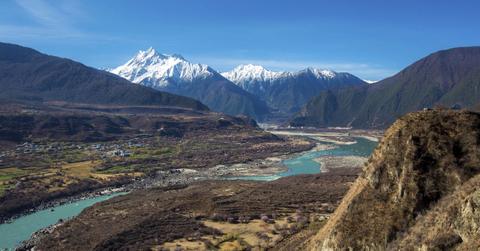Groundbreaking Revelation: Discovery of Tectonic Plates 'Unzipping' Beneath Tibet May Help Predict Future Earthquakes

Seismic activity underneath Tibet is splitting one of the two massive tectonic plates that created Mount Everest, according to a new study that could help predict future earthquake hazards.
Jan. 28 2024, Published 1:02 p.m. ET
A recent study reveals that seismic activity beneath Tibet is causing a split in one of the colossal tectonic plates responsible for the formation of Mount Everest.
This groundbreaking research, presented at the recent American Geophysical Union meeting and published online by The Earth and Space Science Open Archive, offers new insights into the formation of the Himalayas and potential implications for predicting future earthquake hazards.
A collaborative effort involving researchers from the University of California, San Diego, and institutions in the United States and China, the study analyzed earthquake waves in southern Tibet.
The focus was on two tectonic plates: the Indian Plate beneath the Indian Ocean and the Eurasian Plate beneath Eurasia. The collision of these plates around 40 to 50 million years ago led to the formation of the Himalayan mountain range, including Mount Everest.
The study identified a unique process called "delamination" occurring in the Indian Plate, where its dense lower section is peeling away from the upper part.
According to Douwe van Hinsbergen, a geodynamicist from Utrecht University, this behavior challenges previous assumptions about how continents behave and is a fundamental discovery in solid earth science. Scientists had previously supposed tectonic plates could "unzip" like this, as Science notes.
The driving force behind this delamination process is the collision of the plates, with the Indian Plate being compelled northward by currents of molten rock over approximately 60 million years.
Simon Klemperer, a geophysicist at Stanford University, highlighted an area near Bhutan in northeastern India as a prime location for potential tears, given the curved subduction zone.
The study found that the dense base of the Indian Plate detached and sank into the mantle, while the lighter top section continued beneath the surface. Contrary to previous assumptions about buoyancy, ScienceAlert reported that the buoyant Indian continental plate shouldn't sink so easily.
The discovery of a potential tear in the plate, located above the "Cona-Sangri rift" in the Tibetan Plateau, raises questions about its influence on earthquake hazards in Tibet. Although direct links to earthquakes remain uncertain, scientists speculate that tears and peeling of tectonic plates could impact stress build-up and potential quake locations.
Never miss a story — sign up for the Front Page Detectives newsletter. Be on the scene the moment news breaks.
To better understand the dynamics, the research team created 3D imaging models of the seismically active area, suggesting that these models could be valuable for predicting future activity.
Anne Meltzer, a seismologist at Lehigh University and co-author of the study, emphasized that understanding how continents collide not only informs our knowledge of the landscape but also helps assess earthquake hazards along ancient continental collision scars.
Become a Front Page Detective
Sign up to receive breaking
Front Page Detectives
news and exclusive investigations.
